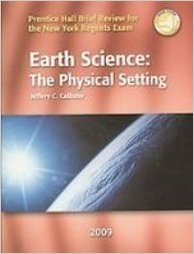
Earth Science: The Physical Setting
1st Edition
ISBN: 9780133200409
Textbook solutions
All Solutions
Page 280: Review Questions
Exercise 1
Result
1 of 1
4
Exercise 2
Result
1 of 1
1
Exercise 3
Result
1 of 1
1
Exercise 4
Result
1 of 1
2
Exercise 5
Result
1 of 1
By indicating that the oldest layer is on the bottom and the youngest layer is on the top, this is happening by using index fossils or radioactive decay dating methods in the sedimentary section.
Exercise 6
Result
1 of 1
2
Exercise 7
Result
1 of 1
1
Exercise 8
Result
1 of 1
3
Exercise 9
Result
1 of 1
3
Exercise 10
Solution 1
Solution 2
Result
1 of 1
lived for a short time, has a wide horizontal distribution and is a single species of life
Result
1 of 1
The index fossil must be distinctive or easily recognizable, abundant, and have a wide geographic distribution and a short range through time.
Exercise 11
Result
1 of 1
The limestone particles.
Exercise 12
Result
1 of 1
4
Exercise 13
Result
1 of 1
1
Exercise 14
Result
1 of 1
4
Exercise 15
Result
1 of 1
2
Exercise 16
Result
1 of 1
3
Exercise 17
Result
1 of 1
4
Exercise 18
Result
1 of 1
2
Exercise 19
Result
1 of 1
2
Exercise 20
Result
1 of 1
Sedimentary rocks form near earth’s surface and most igneous and metamorphic rocks don’t. the high pressure and heat associated with metamorphic and igneous rocks would destroy any evidence of life.
Exercise 21
Result
1 of 1
The Mesozoic Era is the age of dinosaurs and there are no rocks of that age in Elmira.
Exercise 22
Result
1 of 1
4
Exercise 23
Result
1 of 1
1
Exercise 24
Result
1 of 1
2
Exercise 25
Result
1 of 1
3
Exercise 26
Result
1 of 1
1
Exercise 27
Result
1 of 1
4
Exercise 28
Result
1 of 1
1
Exercise 29
Result
1 of 1
3
Exercise 30
Result
1 of 1
2
Exercise 31
Result
1 of 1
2
Exercise 32
Result
1 of 1
3
Exercise 33
Result
1 of 1
3
Exercise 34
Result
1 of 1
3
Exercise 35
Result
1 of 1
2
Exercise 36
Result
1 of 1
Scientific principles generally remain the same with time, thus we can interpret the past of geological history through an understanding of the present.
Exercise 37
Result
1 of 1
3
Exercise 38
Result
1 of 1
4
Exercise 39
Result
1 of 1
2
Exercise 40
Result
1 of 1
2
Exercise 41
Result
1 of 1
2
Exercise 42
Result
1 of 1
4
Exercise 43
Result
1 of 1
3
Exercise 44
Result
1 of 1
4
Exercise 45
Result
1 of 1
1
Exercise 46
Result
1 of 1
Carbon-14 has a short half-life that too little would be left to measure in Ordovician age fossils. due to the age of Ordovician range from 444 to 488 million years old.
Exercise 47
Result
1 of 1
1
Exercise 48
Result
1 of 1
4
Exercise 49
Result
1 of 1
Free Oxygen started to build up in earth’s atmosphere.
Exercise 50
Result
1 of 1
3
Exercise 51
Result
1 of 1
1
Exercise 52
Result
1 of 1
1
unlock

